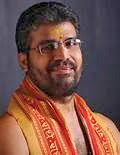The Process of Yoga : 3-3. Swami Krishnananda.
========================================================================
========================================================================
Wednesday, October 19, 2022. 06:00.
Chapter 3: Recognising the Independent Status of Things-3.
=========================================================================
Things in themselves are difficult to perceive, and things as they are perceived are different from things as they really are. We have seen this distinction drawn in common experience among persons, human beings. A person himself or herself, independently, as he or she is individually when alone in their room, is different from a person appearing in public or society. When we are in public or in the external atmosphere of society, we behave in a different way than when we conduct ourselves independently. When we are absolutely alone, unknown, unseen and unobserved, we think and feel in a different manner than when we exhibit our conduct in public life, for reasons known to everyone. This law is perhaps applicable to everything, every object in the world. The thing as it is in itself – the thing in itself, the object as such, the person by himself or herself – is different and is more difficult to study than the same object or person in relation to other persons and things.
When a person is placed in the presence of an object, a new atmosphere is created. When we are in a congregation or a parliament, in a society of persons or bodies, we create an atmosphere that is a little different from the atmosphere we have in our own selves. The reason is that there is a mutual reaction between ourselves and the other persons or objects outside in public, while there is no such reaction when we are alone. This reaction is the cause of our pleasures and pains. The stimulus that is set up by objects disturbs our way of thinking, and we begin to think in terms of the relation that we have already established with the other persons and objects outside, and not independently. Therefore, we have a biased view of things on account of the individual position that we are placed in society. The practice of yoga becomes difficult because of our inability to understand the cosmic relationship in which we are placed as different from the individual or social relationship in which we are usually placed in day-to-day life.
While the two channels of the expression of force, the subjective and the objective, are one at the point of creation, they are different when they ramify themselves into these two channels. This is a matter for deep meditation and analysis by every student of yoga. As I mentioned in the previous session, the object, whatever be its nature, whether inanimate or animate, is a content of our consciousness, on account of which we are able to see or perceive the objects. The entire object is contained in consciousness; and on account of this capacity of the object to enter into the activity of our consciousness, we begin to be aware of an object or a world outside. This is what we call reaction.
To give an analogy, when sunlight falls on an object, the object is illuminated. We begin to see an object outside in sunlight. The object is visible to us on account of the rays of the Sun falling on it. Now, the object itself does not shine. What shines is the light rays of the Sun that have fallen on the object. There is a difference between the light of the Sun and the object that is illuminated; they are not the same. A pot that is put in broad daylight shines, and we say there is a pot in front of us. What we actually see is the illumination shed by sunlight over the surface of the pot. If the sunlight is withdrawn – when the Sun sets, for example – the pot itself becomes invisible. The pot has no character of shining and, therefore, it is not in a position to be seen or perceived by the percipient unless there is an associating factor – sunlight. But when we look at an object, we do not make a distinction between the light and the object. There is a superimposition, as it is called, between the light and the object. The object is shining, we say. The object does not shine; it is the light that is shining, but because we are unable to distinguish between the light and the object, we make the mistake of asserting that the object is shining.
*****
To be continued
=========================================================================









Comments